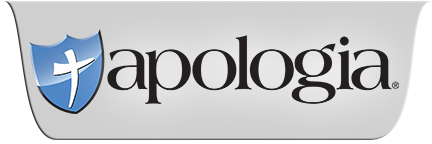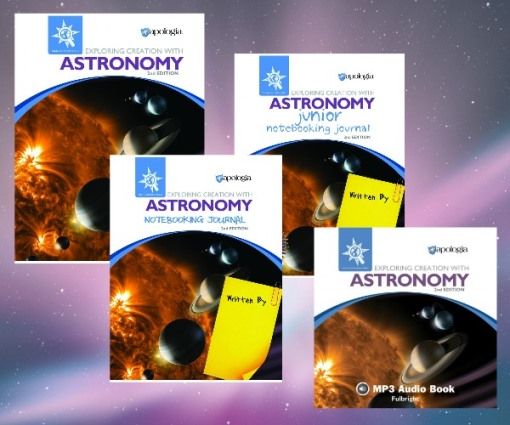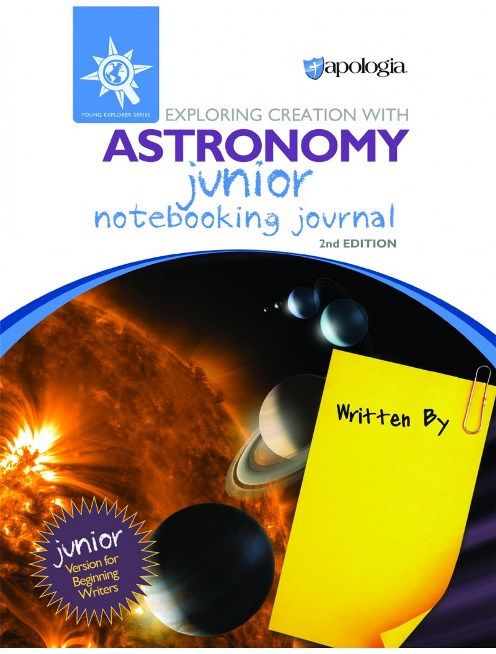
We’ve had so much fun with Apologia elementary sciences in the past that we were eagerly anticipating the chance to review the newly revised Exploring Creation with Astronomy, 2nd Edition by Apologia Educational Ministries.
WHAT IS IT?:
Exploring Creation with Astronomy, 2nd Edition is an elementary science program for grades K-6. It includes 14 lessons that explain astronomy and discuss the sun, moon, and each of the planets, plus space rocks, the Kuiper Belt, dwarf planets, stars, galaxies, and space travel.
This new edition includes tons of beautiful, full-color photographs and illustrations to capture your students’ interest.
The set I received includes:
- Student Text – $29.25 (sample)
- Notebooking Journal – $20.25 (sample)
- Junior Notebooking Journal –$20.25 (sample)
- Audio CD – $21.25 (sample)
In addition, Apologia just released a supplemental Science Kit that includes 21 additional experiments, instructions, and most of the supplies needed to complete all 63 of the activities in the program. I didn’t receive that (wish I had!) since it just became available in the last few days, but I can certainly see how it would make the activities even easier to complete.
OUR EXPERIENCE:
My 8-year old son, Holden, was really looking forward to trying out the Astronomy program. He loves anything science-related, so even if it means extra word in addition to our regular school work, he doesn’t mind at all.
In the past when I’ve tried other books in the Exploring Creation series, I found the reading to be pretty heavy, so I was thrilled to also receive the audio CD, which includes the full-text read aloud. But to my surprise, this revised edition seems to have just the right amount of text to keep Holden’s interest, so that’s an obvious improvement to me. I was still happy to use the CD to give myself a break from reading aloud, and it also adds a bit of dramatization to the reading that he enjoys.
We also received both the regular and junior versions of the notebooking journals. The major differences between the two are that the junior journal has handwriting lines  for the copywork and starting letters for the crossword answers, and where the regular journal has open-ended questions to answer, the junior journal instead has coloring pages. So the junior version has some extra helps and less writing, but both journals include both print and cursive versions for all of the copywork. Holden is just starting 3rd grade and doesn’t have great fine motor control yet, so we used the junior journal. I took dictation for most of the writing (except for copywork), and I did the cutting and pasting for the mini-books and other notebooking elements. We just discussed the content orally, and we went over the finished elements together. If his older sister had been interested in astronomy, I would have had her use the regular journal so she could have done the review questions for each lesson as a written assignment. Holden and I just did those orally, since they are also included in the textbook. But having both journals makes it a cinch to combine two children in different grade levels into one program.
for the copywork and starting letters for the crossword answers, and where the regular journal has open-ended questions to answer, the junior journal instead has coloring pages. So the junior version has some extra helps and less writing, but both journals include both print and cursive versions for all of the copywork. Holden is just starting 3rd grade and doesn’t have great fine motor control yet, so we used the junior journal. I took dictation for most of the writing (except for copywork), and I did the cutting and pasting for the mini-books and other notebooking elements. We just discussed the content orally, and we went over the finished elements together. If his older sister had been interested in astronomy, I would have had her use the regular journal so she could have done the review questions for each lesson as a written assignment. Holden and I just did those orally, since they are also included in the textbook. But having both journals makes it a cinch to combine two children in different grade levels into one program.
In the front of the journals, there is a convenient suggested schedule that breaks down the 14 lessons into 71 daily assignments, which you can complete at the pace that suits your schedule. If you did just two daily assignments per week, the content would last you a full school year. We didn’t follow any particular pace…we just picked it up when it fit into our schedule and very much enjoyed taking a leisurely pace. Our goal was to complete the first two lessons (11 daily assignments) during the review period, so that’s what we did.
The daily assignments in the journals include the reading/listening assignments, the activities included in the textbook and journal, as well as the activities that are part of the separate Science Kit which you can purchase as an additional option. If you don’t choose to purchase the optional kit, these assignments are clearly marked on the schedule and can easily be skipped.
Lesson 1 was about what astronomy is, so we spent about two weeks working 
He also created his own mnemonic to help him remember the order of the planets in our solar system. He loves to be silly, so that was fun! He had to create
Then he worked on his copywork. Holden has trouble writing small enough to fit his words on handwriting lines, but he managed to pull it off! I could see that he was trying really hard to do a good job. All of the pages in the journal have full-color b
Next, we got to make a matchbook about astronomy where we recorded definitions for the vocabulary words in this lesson: constellations, Galileo, Stonehenge, NASA, Hubble, Nicholas Conpernicus, natural satellite, and artificial satellite.
Last, we did an astronomy crossword puzzle using words in a word bank, and the first letter of each answer was already filled in on the puzzle to help him get started, but he did really well with that, even without the hints. I could tell that h
The journal also had pages to scrapbook any other activities he might have done, which is great for families that like to add additional experiences to their learning like field trips and such. He also got to color two coloring pages of related scripture verses from Matthew 2:9 and Psalms 33:6. I thought that was a nice touch, and Holden surprisingly enjoyed the opportunity to color those pages.
Lesson 2 was all about the sun. Holden did a number of simple activities in this lesson, including understanding distance and size by holding up his finger in front of him and comparing the appearance of its size to a house outside the window that was off in the distance. He was surprised at how that appeared, so it helped him understand perspective and why the sun looks so small in the sky when it’s infinitely larger than our whole planet. He also got to concentrate the heat from the sun’s rays with a magnifying glass and see how doing so melts butter even faster than it just being out in the sun. Then he got to give a speech about why people shouldn’t look directly at the sun. I figured this was a golden opportunity for a cute video, so I recorded it for your entertainment…I mean enjoyment!
Then we made a sun wheel mini-book that revealed our definitions for terms related to the sun. I really like the many interactive and creative ways the journal gets kids to define the vocabulary words from each lesson. It sure beats the way I did them in school!
Then we enlisted his sister’s help so the three of us could represent the sun, moon, and Earth. We demonstrated the concepts of revolving and rotating and moved around the room in the way that the Earth rotates and revolves around the sun at the same time that the moon revolves around the Earth. You can imagine how chaotic that became, and it all ended with lots of laughing and dizziness!
H
Next, we learned all about solar flares, auroras, and sunspots and did some more scripture copywork from Psalm19:1. Then we got to learn all about the colors in light that comes from the sun. There were a couple of optional activities listed for the separate Science Kit, so we just skipped over those. Then we made a rainbow mini-book. Inside the flip-up mini-book, we recorded what we’d learned about seeing colors.
Then we lis

Next, we did a cool vocabulary activity in the journal where I spread out the terms, and he read the definition and selected the right word. Then I glued it down as a flap that would reveal the definition underneath. We made a whole page of these to reinforce the new terms from the chapter. Again, the full-color illustrations in the journal made this visually interesting!
The next activity was to make a pinhole eclipse viewing box. I didn’t have a 
In just these 2 of the 14 lessons in this set, Holden and I learned so many interesting facts about the solar system! We enjoyed listening to the CD and then working on the journal and activities together. I really like the way the suggested schedule breaks down all of the work into bite-sized chunks…it makes lesson planning so much easier, because we can literally open it and go! And Holden is a boy who really likes to understand how things work, so the explanations and demonstrations in this program really helped to satisfy his desire to understand the “whys” behind the facts.
If you’re looking for a truly complete science program and a student who is curious about astronomy, then this is for you! The materials are so visually attractive, and there are plenty of hands-on activities to keep all kinds of learners engaged and applying what they’ve learned. We really had fun exploring this program together!
Check out what other Crew members had to say about this product by clicking the banner below.


No comments:
Post a Comment